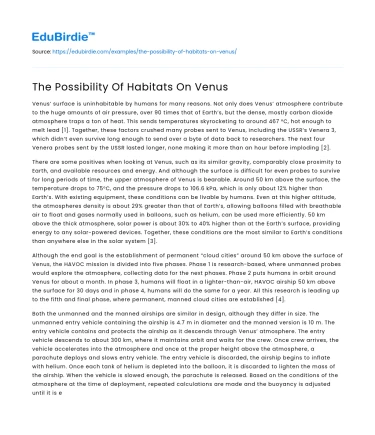Venus’ surface is uninhabitable by humans for many reasons. Not only does Venus’ atmosphere contribute to the huge amounts of air pressure, over 90 times that of Earth’s, but the dense, mostly carbon dioxide atmosphere traps a ton of heat. This sends temperatures skyrocketing to around 467 °C, hot enough to melt lead [1]. Together, these factors crushed many probes sent to Venus, including the USSR’s Venera 3, which didn’t even survive long enough to send over a byte of data back to researchers. The next four Venera probes sent by the USSR lasted longer, none making it more than an hour before imploding [2].
There are some positives when looking at Venus, such as its similar gravity, comparably close proximity to Earth, and available resources and energy. And although the surface is difficult for even probes to survive for long periods of time, the upper atmosphere of Venus is bearable. Around 50 km above the surface, the temperature drops to 75°C, and the pressure drops to 106.6 kPa, which is only about 12% higher than Earth’s. With existing equipment, these conditions can be livable by humans. Even at this higher altitude, the atmospheres density is about 29% greater than that of Earth’s, allowing balloons filled with breathable air to float and gases normally used in balloons, such as helium, can be used more efficiently. 50 km above the thick atmosphere, solar power is about 30% to 40% higher than at the Earth’s surface, providing energy to any solar-powered devices. Together, these conditions are the most similar to Earth’s conditions than anywhere else in the solar system [3].
Save your time!
We can take care of your essay
- Proper editing and formatting
- Free revision, title page, and bibliography
- Flexible prices and money-back guarantee
Although the end goal is the establishment of permanent “cloud cities” around 50 km above the surface of Venus, the HAVOC mission is divided into five phases. Phase 1 is research-based, where unmanned probes would explore the atmosphere, collecting data for the next phases. Phase 2 puts humans in orbit around Venus for about a month. In phase 3, humans will float in a lighter-than-air, HAVOC airship 50 km above the surface for 30 days and in phase 4, humans will do the same for a year. All this research is leading up to the fifth and final phase, where permanent, manned cloud cities are established [4].
Both the unmanned and the manned airships are similar in design, although they differ in size. The unmanned entry vehicle containing the airship is 4.7 m in diameter and the manned version is 10 m. The entry vehicle contains and protects the airship as it descends through Venus’ atmosphere. The entry vehicle descends to about 300 km, where it maintains orbit and waits for the crew. Once crew arrives, the vehicle accelerates into the atmosphere and once at the proper height above the atmosphere, a parachute deploys and slows entry vehicle. The entry vehicle is discarded, the airship begins to inflate with helium. Once each tank of helium is depleted into the balloon, it is discarded to lighten the mass of the airship. When the vehicle is slowed enough, the parachute is released. Based on the conditions of the atmosphere at the time of deployment, repeated calculations are made and the buoyancy is adjusted until it is equal to the weight of the vehicle, where it will maintain a constant height (figure 1). The airship itself is equipped with solar panels, a thermal protection system, and additional radiation protection to ensure sustainable flights [5]. The airship resembles a modern “blimp”, or a non-rigid airship, with a propulsion system and fins to guide it through the air (figure 2) [6].
There are three habitats the manned missions use: the transit habitat, the atmospheric habitat, and the ascent habitat. The transit habitat transports the crew from the Earth-launched spacecraft to the HAVOC vehicle already 300 km in orbit above Venus’ surface. The crew inhabits this for around 400 days while transitioning from Earth to Venus, until they transfer to the atmospheric habitat. This is where the crew lives during the deployment and use of the airship in Venus’ upper-atmosphere, and is held on the underside of the balloon. Once the upper atmosphere portion of the mission is done, the crew enters the ascent habitat, which was carried under the balloon, behind the atmospheric habitat. This portion takes the astronauts back to the transit habitat, which returns to Earth [3].
References
- https://www.space.com/18526-venus-temperature.html
- https://seanmunger.com/2015/08/17/twenty-three-minutes-on-venus-the-hellish-voyage-of-venera-7/#targetText=On%20December%2015%2C%201970%2C%20the,descent%20toward%20the%20Venusian%20surface.
- Arney, Dale & Jones, Christopher. (2015). High Altitude Venus Operational Concept (HAVOC): An Exploration Strategy for Venus. 10.2514/6.2015-4612. https://www.researchgate.net/publication/299905943_High_Altitude_Venus_Operational_Concept_HAVOC_An_Exploration_Strategy_for_Venus
- https://www.space.com/29140-venus-airship-cloud-cities-incredible-technology.html
- https://ntrs.nasa.gov/archive/nasa/casi.ntrs.nasa.gov/20150006858.pdf
- https://sacd.larc.nasa.gov/smab/havoc/






 Stuck on your essay?
Stuck on your essay?

